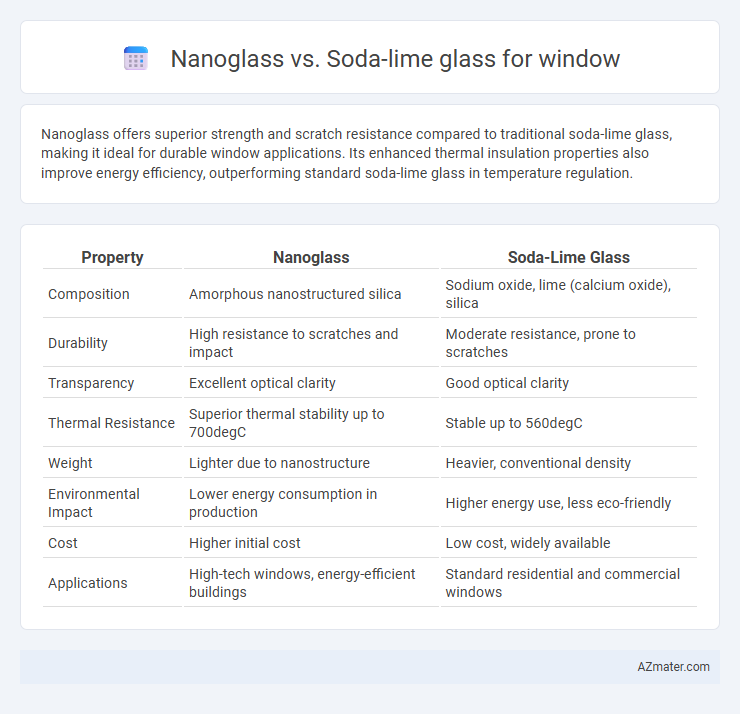Nanoglass offers superior strength and scratch resistance compared to traditional soda-lime glass, making it ideal for durable window applications. Its enhanced thermal insulation properties also improve energy efficiency, outperforming standard soda-lime glass in temperature regulation.
Table of Comparison
| Property | Nanoglass | Soda-Lime Glass |
|---|---|---|
| Composition | Amorphous nanostructured silica | Sodium oxide, lime (calcium oxide), silica |
| Durability | High resistance to scratches and impact | Moderate resistance, prone to scratches |
| Transparency | Excellent optical clarity | Good optical clarity |
| Thermal Resistance | Superior thermal stability up to 700degC | Stable up to 560degC |
| Weight | Lighter due to nanostructure | Heavier, conventional density |
| Environmental Impact | Lower energy consumption in production | Higher energy use, less eco-friendly |
| Cost | Higher initial cost | Low cost, widely available |
| Applications | High-tech windows, energy-efficient buildings | Standard residential and commercial windows |
Introduction to Nanoglass and Soda-Lime Glass
Nanoglass is an advanced material featuring nanoparticles that enhance strength, transparency, and thermal insulation compared to traditional glass types. Soda-lime glass, the most common form used in windows, consists primarily of silica, soda, and lime, offering affordability and ease of production but with lower durability and energy efficiency than nanoglass. Innovations in nanoglass technology provide superior resistance to scratches and impacts, making it an optimal choice for high-performance window applications.
Composition and Manufacturing Process
Nanoglass features a nanoscale silica glass structure engineered through a sol-gel process, resulting in enhanced strength and transparency compared to soda-lime glass, which is primarily composed of silica (SiO2), sodium oxide (Na2O), and calcium oxide (CaO) melted at high temperatures. The manufacturing of nanoglass involves controlled condensation of silica nanoparticles that form a dense, uniform matrix with fewer imperfections, while soda-lime glass is produced by melting raw materials at around 1500degC followed by shaping and annealing. This difference in composition and production techniques grants nanoglass superior mechanical properties and optical clarity, making it suitable for advanced window applications.
Mechanical Strength and Durability
Nanoglass offers significantly higher mechanical strength compared to traditional soda-lime glass, with improved resistance to impact and bending stress due to its nanostructured composition. Its durability surpasses soda-lime glass by providing enhanced scratch resistance and better performance under extreme weather conditions, making it ideal for long-term window applications. The superior mechanical properties of nanoglass reduce the likelihood of cracks and breaks, resulting in lower maintenance and replacement costs over time.
Optical Clarity and Transparency
Nanoglass exhibits superior optical clarity compared to soda-lime glass due to its nano-scale structure that minimizes light scattering and enhances transparency. Soda-lime glass, while cost-effective, often contains impurities and microscopic imperfections that reduce its overall transparency and optical performance. Nanoglass offers higher light transmittance rates, making it ideal for applications demanding maximum window visibility and clarity.
Thermal Insulation and Energy Efficiency
Nanoglass offers superior thermal insulation compared to traditional soda-lime glass, significantly reducing heat transfer through windows. Its advanced nanoscale coatings and multilayer structures enhance energy efficiency by maintaining indoor temperatures and lowering HVAC energy consumption. In contrast, soda-lime glass exhibits higher thermal conductivity, resulting in greater heat loss and less effective energy savings.
Resistance to Scratches and Stains
Nanoglass exhibits superior resistance to scratches and stains compared to traditional soda-lime glass, making it ideal for high-contact window surfaces. Its advanced nanocoating technology creates a durable, hydrophobic layer that repels dirt, oils, and water, significantly reducing staining and abrasion over time. Soda-lime glass, being softer and more porous, is more prone to surface damage and staining, which diminishes its clarity and longevity in window applications.
Environmental Impact and Sustainability
Nanoglass offers superior energy efficiency compared to traditional soda-lime glass by dramatically improving insulation and reducing heating and cooling demands in buildings. Soda-lime glass, while widely recyclable and abundant, requires significant energy for manufacturing due to high-temperature melting processes, contributing to higher CO2 emissions. The advanced coatings in nanoglass enhance solar control and thermal performance, promoting sustainability through reduced carbon footprints and longer lifespan, making it an environmentally preferable choice for eco-conscious window applications.
Cost and Availability
Nanoglass windows offer superior energy efficiency and durability but come with a significantly higher price compared to traditional soda-lime glass, which remains the most cost-effective option for large-scale use. Soda-lime glass dominates global market availability due to its widespread production and established supply chains, making it readily accessible for residential and commercial windows. Nanoglass technology is emerging, with limited manufacturers and higher production costs, restricting its availability primarily to premium or specialized projects.
Suitable Applications for Windows
Nanoglass offers superior thermal insulation and enhanced UV protection, making it ideal for energy-efficient windows in residential and commercial buildings. Soda-lime glass, widely used due to its cost-effectiveness and ease of manufacturing, suits standard window applications where basic transparency and durability are sufficient. Nanoglass's advanced properties support smart window systems and high-performance architectural designs requiring better light control and environmental comfort.
Conclusion: Choosing the Right Glass for Your Windows
Nanoglass offers superior thermal insulation and enhanced durability compared to traditional soda-lime glass, making it ideal for energy-efficient windows. Soda-lime glass remains a cost-effective option with satisfactory performance for standard residential applications. Selecting the right glass depends on balancing budget constraints with desired performance features such as energy savings and longevity.

Infographic: Nanoglass vs Soda-lime glass for Window
 azmater.com
azmater.com